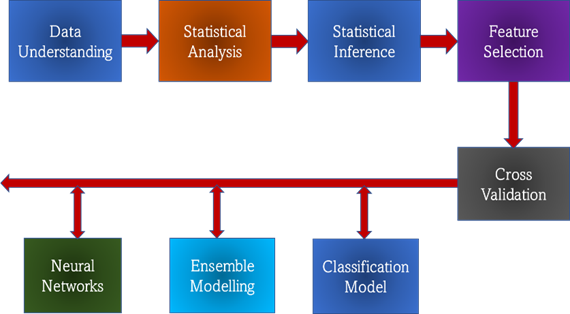Statistical Analysis and Deep Learning Associated Modeling for Early stage Detection of Carinoma
Main Article Content
Abstract
The high death rate and overall complexity of the cancer epidemic is a global health crisis. Progress in cancer prediction based on gene expression has increased in light of the speedy advancement using modern high-throughput sequencing methods and a wide range of machine learning techniques, bringing insights into efficient and precise treatment decision-making. Therefore, it is of significant interest to create machine learning systems that accurately identify cancer patients and healthy people. Although several classification systems have been applied to cancer prediction, no single strategy has proven superior. This research shows how to apply deep learning to an optimization method that uses numerous machine learning models. Statistical analysis has helped us choose informative genes, and we've been feeding those to five different categorization models. The results from the five different classifiers are ensembled in the next step using a deep learning technique. The three most common types of adenocarcinoma are those of the lungs, stomach, and breasts. The suggested deep learning-based inter-ensembles model was tested with deep learning-based algorithms on Carcinoma data. The results of the tests show that relative to using only one set of classifiers or the simple consensus algorithm, it improves the precision of cancer prognosis in every analyzed carcinoma dataset. The suggested deep learning-based inter-ensemble approach is demonstrated to be reliable and efficient for cancer diagnosis by entirely using diverse classifiers.
Article Details
References
L. Zender, A. Villanueva, V. Tovar, D. Sia, D. Y. Chiang, and J. M. Llovet, "Cancer gene discovery in hepatocellular carcinoma," J. Hepatol., vol. 52, no. 6, pp. 921–929, 2010.
U. Magriples, F. Naftolin, P. E. Schwartz, and M. L. Carcangiu, "High-grade endometrial carcinoma in tamoxifen-treated breast cancer patients.," J. Clin. Oncol., vol. 11, no. 3, pp. 485–490, 1993.
I. Mármol, C. Sánchez-de-Diego, A. Pradilla Dieste, E. Cerrada, and M. J. Rodriguez Yoldi, "Colorectal carcinoma: a general overview and future perspectives in colorectal cancer," Int. J. Mol. Sci., vol. 18, no. 1, p. 197, 2017.
S. Chand and others, "A comparative study of breast cancer tumor classification by classical machine learning methods and deep learning method," Mach. Vis. Appl., vol. 31, no. 6, pp. 1–10, 2020.
C. Natale, G. Z. Leinwand, J. Chiang, J. L. Silberstein, and L. S. Krane, "Reviewing the demographic, prognostic, and treatment factors of primary adenocarcinoma of the bladder: a SEER population-based study," Clin. Genitourin. Cancer, vol. 17, no. 5, pp. 380–388, 2019.
J. Breyer et al., "ESR1, ERBB2, and Ki67 mRNA expression predicts stage and grade of non-muscle-invasive bladder carcinoma (NMIBC)," Virchows Arch., vol. 469, no. 5, pp. 547–552, 2016.
S. Kuba et al., "Total thyroidectomy versus thyroid lobectomy for papillary thyroid cancer: comparative analysis after propensity score matching: a multicenter study," Int. J. Surg., vol. 38, pp. 143–148, 2017.
C. Rosty and M. Goggins, "Early detection of pancreatic carcinoma," Hematol. Clin., vol. 16, no. 1, pp. 37–52, 2002.
R. Suarez-Ibarrola, S. Hein, G. Reis, C. Gratzke, and A. Miernik, "Current and future applications of the machine and deep learning in urology: a review of the literature on urolithiasis, renal cell carcinoma, and bladder and prostate cancer," World J. Urol., vol. 38, no. 10, pp. 2329–2347, 2020.
K. V. R. Kumar and S. Elias, "Smart Neck-Band for Rehabilitation of Musculoskeletal Disorders," 2020.
K. V. R. Kumar, B. R. Devi, M. Sudhakara, G. Keerthi, and K. R. Madhavi, "AI-Based Mental Fatigue Recognition and Responsive Recommendation System," in Intelligent Computing and Applications, Springer, 2023, pp. 303–314.
K. V. R. Kumar and S. Elias, "Real-Time Tracking of Human Neck Postures and Movements," in Healthcare, 2021, vol. 9, no. 12, p. 1755.
G. S. Tandel et al., "A review on a deep learning perspective in brain cancer classification," Cancers (Basel)., vol. 11, no. 1, p. 111, 2019.
M. Olempska, P. A. Eisenach, O. Ammerpohl, H. Ungefroren, F. Fandrich, and H. Kalthoff, "Detection of tumor stem cell markers in pancreatic carcinoma cell lines," Hepatobiliary Pancreat Dis Int, vol. 6, no. 1, pp. 92–97, 2007.
L. Zhou, J. Liu, and F. Luo, "Serum tumor markers for detection of hepatocellular carcinoma," World J. Gastroenterol. WJG, vol. 12, no. 8, p. 1175, 2006.
R. Tabares-Soto, S. Orozco-Arias, V. Romero-Cano, V. S. Bucheli, J. L. Rodr’iguez-Sotelo, and C. F. Jiménez-Varón, "A comparative study of machine learning and deep learning algorithms to classify cancer types based on microarray gene expression data," PeerJ Comput. Sci., vol. 6, p. e270, 2020.
S. D. Bhogaraju, K. V. R. Kumar, P. Anjaiah, J. H. Shaik, and others, "Advanced Predictive Analytics for Control of Industrial Automation Process," in Innovations in the Industrial Internet of Things (IIoT) and Smart Factory, I.G.I. Global, 2021, pp. 33–49.
E. M. K. Reddy, A. Gurrala, V. B. Hasitha, and K. V. R. Kumar, "Introduction to Naive Bayes and a Review on Its Subtypes with Applications," Bayesian Reason. Gaussian Process. Mach. Learn. Appl., pp. 1–14, 2022.
Ramana, K., Kumar, M. R., Sreenivasulu, K., Gadekallu, T. R., Bhatia, S., Agarwal, P., & Idrees, S. M. (2022). Early prediction of lung cancers using deep saliency capsule and pre-trained deep learning frameworks. Frontiers in oncology, 12.
Rudra Kumar, M., Pathak, R., & Gunjan, V. K. (2022). Diagnosis and Medicine Prediction for COVID-19 Using Machine Learning Approach. In Computational Intelligence in Machine Learning (pp. 123-133). Springer, Singapore.
Reddy, K. U. K., Shabbiha, S., & Kumar, M. R. (2020). Design of high security smart health care monitoring system using IoT. Int. J, 8.

